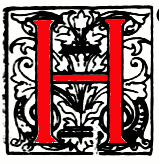
Left: Plate XIb, border and initial B from Braybrooke Psalter. Henry Shaw (1800-73) and Sir Frederick Madden (1801-73), 28.9 x 23.5 cm. [detail] Collection: Anonymous Lender. This item was catalogue no. 14 in Beckwith, Victorian Bibliomania (1987) With thanks to the Center for Digital Scholarship and Digital Production Services in the Brown University Library for producing the color image used in this web version. [Click on images to enlarge them.]
Commentary by Alice H. R. H. Beckwith

enry Shaw and Frederic Madden's book was the first of many British nineteenth-century studies of illuminated manuscripts designed tor the general reader as well as artists and scholars (Munby, 141). Such books opened the public's eyes to the aesthetic and historical value of manuscript arts and led to the fashion for illuminated sacred and secular texts in the Victorian period. In addition, Shaw and Madden began sensitizing their readers to the relationships between the art of the book and other art forms. Madden believed that the scribal arts "formed a connecting link between the ancient and modem schools of painting." As assistant curator of manuscripts at the British Museum, he was well acquainted with illuminated manuscripts, while Shaw was an architectural draughtsman, watercolorist, and antiquarian who published numerous books about historic ornament for architects and other designers (cats. 38-40). The format of Shaw and Madden's book was a model for nineteenth-century studies of the history and methods of illumination, consisting of a general introduction followed by examples of ornament from manuscripts in public and private collections, arranged in chronological order and described in the accompanying text.
Illuminated Ornaments received contemporary praise, and Madden's analysis of the plates was reviewed in the 1834 Gentleman's Magazine. The twentieth-century scholars Alan N. W. Munby and Carl Nordenfalk take note of Madden's work in their books, crediting him with writing the "most sensible and coherent essay about miniature painting at the time" (Munby, 140) and endorsing some aspects of the book's continuing usefulness (Nordenfalk, 140).
Madden defined the essence of illumination as its color, noting that the only works available to the general reader in 1833 were not illustrated with color plates. Shaw colored the forty copperplate line engravings in Illuminated Ornaments by hand with opaque watercolors (Friedman, 18). Nordenfalk suggests that Shaw used stencils to color the plates after the outlines were laid down by the press (140), but the white highlights in the examples illustrated here and in the other plates in the book indicate that this color at least was done freehand. Handcoloring was a time-consuming, labor-intensive process superseded by chromolithography and wood-engraving in the following decades.
In this illustration of sections of the Braybrooke Psalter, the opaque yellow paint (substituting for gold) and the alternating checkerboard of blue and red into which the historiated initial B is set are decidedly nineteenth-century in style. However, the page does display a feeling for the complex variety found in an original manuscript by representing the different kinds of ornament characteristic of medieval book arts: marginalia including leafy vines and extenders, historiated and geometric illuminated initial letters, line endings, and grotesques such as the bearded humanheaded animal above the initial B. The rather weak version of the Gothic script also echoes medieval texts.
Not as progressive in his view of the development of manuscript illumination as John Ruskin, Madden superimposed a critical system on hand-illumination in general which followed the lead of the sixteenth-century critic Giorgio Vasari, who saw a continuous development toward the achievements of his contemporary, Giulio Clovio. Illuminated Ornaments is biased towards the fifteenth century by the number of examples selected from that century—twenty-two out of forty, with only two thirteenth-century examples, the present Psalter and illustration IX, included. Nevertheless, Illuminated Ornaments is a landmark in the diffusion of information about manuscript arts and their history and made a significant contribution to Victorian bibliomania.
You may use these images without prior permission for any scholarly or educational purpose as long as you link your document to this URL in a web document or cite the Victorian Web in a print one.]
References
Beckwith, Alice H. R. H. Victorian Bibliomania: The Illuminated Book in Nineteenth-Century Britain. Exhibition catalogue. Providence. Rhode Island: Museum of Art, Rhode Island School of Design, 1987.
Munby, A. N. L.Connoisseurs and Medieval Manuscripts, 1750-1850. Oxford: Clarendon Press, 1970.
Friedman, Joan. Colour Printing in Britain, 1496-1870. New Haven: Yale Center for British Art, 1978.
Nordenfalk, Carl Adam Johan. Celtic and Anglo-saxon painting : book illumination in the British Isles 600-800. New York : G. Braziller, 1977.
Shaw, Henry, and Sir Frederick Madden. Illuminated Ornaments. London: William Pickering. Printer: Charles Wittingham. Etching: Henry Shaw. Binder: John F. Trow & Son.
Last modified 27 December 2013